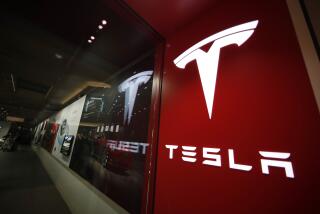Column: No, Elon, the price of the Model 3 isn’t lower just because owners will save money on gas
- Share via
Tesla boss Elon Musk blew up the internet via Twitter on Tuesday — again! — with a tweet declaring that the “starting cost” of the company’s mass-market Model 3 electric sedan has fallen to $35,000.
That would be significant, since the $35,000 electric vehicle has been Tesla’s Holy Grail almost since the company’s inception. The idea has been that Tesla can’t be a mainstream EV company if it’s only selling luxury models for $75,000 and up.
Significant … if true.
Unfortunately, as numerous Tesla mavens pointed out on Twitter almost instantly after Musk’s tweet landed at 11:05 p.m. Tuesday, it’s not really true. It’s incorrect to imply that the list price of any Model 3 is now only $35,000.
As it happens, Musk and Tesla weren’t really claiming that anyone could buy a Model 3 for $35,000. That figure is their calculation of the cost to a buyer after two factors are netted out. One is the federal government rebate, which is now $3,750 per Tesla vehicle. That’s legitimate to include in the price calculation, since it’s paid directly to the buyer.
The other factor is much more dubious. Tesla calls it “gas savings”— in other words, its judgment of how much less the buyer will spend on gasoline during the putative six-year life of the Tesla, compared with a standard gas-fueled car.
Tesla’s critics, including not a few short sellers, jumped all over Musk’s attempt to net out gasoline savings from the price of the car. They’re right. No one will drive a Model 3 off a Tesla facility for $4,300 less, unless Tesla intends to give the buyer a point-of-purchase credit of that sum. Tesla isn’t proposing that.
In the words of one tweeter — a self-described EV fan — “There are no ‘gas savings’ realized in the purchase of a vehicle that does not use gas. The $4,300 is never ‘saved’ by the customer. It is ‘paid’ to Tesla. The price is entirely for deception.”
One reason for the skepticism is that Tesla is facing questions about demand for its vehicles, especially the Model 3. As my colleague Russ Mitchell reported, U.S. sales of the Model 3 fell off a cliff in January, in part because government incentives were cut. During a conference call following the company’s fourth-quarter earnings report, Musk said that “demand for the Model 3 is insanely high. The inhibitor is that people don’t have the money to buy one.”
The company did cut the list price of its Model 3 sedans by $1,100 recently, in part to compensate for the reduced federal incentives.
Musk defended his claim of a $35,000 cost, also via Twitter, by observing that “both prices [i.e., before and after incentives and gas savings] are shown right next to each other & lower price is *actually* the real apples to apples cost vs a fuel car.”
Yet there’s a big difference between “price” and “cost,” and also between “price” and “value.” The $35,000 is the cost of ownership, or the value to the customer — not the price, which Tesla lists as $42,900 for the entry-level, midrange, rear-wheel-drive Model 3. (That’s the price after the $1,100 cut.)
A Tesla spokeswoman says that the company has been citing its vehicles’ gas savings over comparable gasoline cars for years, though she couldn’t be certain that the figure has appeared on its website consistently.
It’s probably true that Tesla customers will sit down at some point and figure out their gains in fuel costs, and factor that into the cost of the car. Indeed, the Tesla spokeswoman told me that one of the most frequent questions asked by would-be customers is how much they’ll save on fuel. But it’s doubtful they think they’d be forking over that much less to drive the Tesla away.
If Musk really wanted to show the “cost” of the Model 3, he’d have to add in at least a couple of factors that raise the cost — such as sales taxes and supercharging fees on the road.
Tesla says it bases the “gas savings” on a putative customer’s average annual driving mileage of up to 15,000 miles a year, a gas price of $2.85 per gallon, and fuel economy of 28 miles per gallon for a car similar to a BMW 3 series. The company assumes an average electricity cost of 13 cents per kilowatt-hour to charge its vehicles.
The arithmetic is accurate enough, but the assumptions are fairly broad. What if the customer is changing over from, say, a Toyota Prius, which might deliver nearly 50 miles per gallon? Is it reasonable to assume a Tesla owner will put 15,000 miles on a car that can’t be charged anywhere in the country, on demand, compared with a gasoline-powered vehicle that can be refueled anywhere?
In any case, what’s really questionable about Musk’s tweet is the implication that the prices of his vehicles have come down by the amount of the gas savings. They haven’t.
Keep up to date with Michael Hiltzik. Follow @hiltzikm on Twitter, see his Facebook page, or email michael.hiltzik@latimes.com.
Return to Michael Hiltzik’s blog.
More to Read
Inside the business of entertainment
The Wide Shot brings you news, analysis and insights on everything from streaming wars to production — and what it all means for the future.
You may occasionally receive promotional content from the Los Angeles Times.











